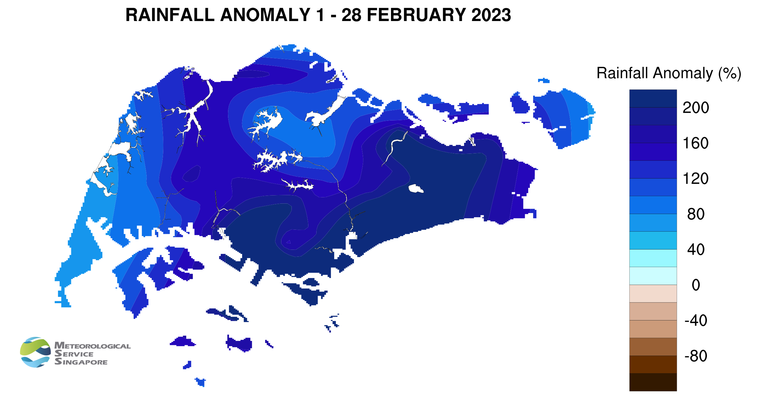Singapore, 1 March 2023 – The prevailing Northeast Monsoon conditions are expected to continue into the first fortnight of March 2023, with the low-level winds blowing from the northwest or northeast.
2 The widespread and continuous rainy conditions experienced in the end of February are likely to gradually ease in early March 2023. In the first week of the fortnight, the monsoon rain band is forecast to remain over the equatorial region and thundery showers are expected in the afternoon on most days. The showers may extend into the evening on a few days. The latter half of the fortnight is forecast to be relatively drier, with localised short-duration thundery showers expected in the late afternoon over parts of the island on some days. Overall, the total rainfall for the first half of March 2023 is forecast to be above average over most parts of Singapore.
3 During the fortnight, the daily temperature is expected to range between 24 degrees Celsius and 33 degrees Celsius on most days, and may reach around 34 degrees Celsius on a few days when there is less cloud cover.
4 For updates of the daily weather forecast, please visit the MSS website (https://www.weather.gov.sg), NEA website (www.nea.gov.sg), or download the myENV app.
REVIEW (1 – 28 February 2023)
5 Northeast Monsoon conditions prevailed over Singapore and the surrounding region in February 2023. The low-level winds blew from the northwest or northeast.
6 The second half of February 2023 was generally dry until the end of the month. On 28 February 2023, the strengthening of the high-pressure system over the northern Asian continent brought a surge of strong north-easterly winds (or monsoon surge[1]) over the South China Sea. The monsoon surge brought widespread continuous moderate to heavy thundery showers over Singapore and the surrounding region with all stations across the island recording more than 100mm of rainfall. The rain was heaviest over the eastern and southern parts of Singapore with the highest daily total rainfall of 225.5mm recorded at Kallang. This was the highest daily total rainfall ever recorded in February, exceeding the previous record of 159.3mm on 4 February 1995
7 In February 2023, the daily maximum temperature was below 33 degrees Celsius on most days. The highest daily maximum temperature of 34.2 degrees Celsius was recorded at Ang Mo Kio on 10 February 2023 while the lowest daily minimum temperature of 21.3 degrees Celsius was recorded at Jurong on 15 February 2023.
8 Well above average rainfall was received across the island in February 2023. The highest anomaly of 281 per cent above average was recorded at around Tanjong Katong area. The anomaly was lowest at Mandai at 81 per cent above average.
[1] A monsoon surge refers to a strengthening of winds over the South China Sea, causing extensive rainclouds to form over our surrounding region. Read more at https://www.weather.gov.sg/learn_weather_systems/
CLIMATE STATION STATISTICS
Long-term Statistics for March
(Climatological reference period: 1991 – 2020)
| Average daily maximum temperature: | 32.2 °C |
| Average daily minimum temperature: | 24.9 °C |
| Average monthly temperature: | 27.8 °C |
| Average rainfall: | 151.7 mm |
| Average number of rain days: | 12 |
Historical Extremes for March
(Rainfall since 1869 and temperature since 1929)
| Highest monthly mean daily maximum temperature: | 34.1 °C (1998) |
| Lowest monthly mean daily minimum temperature: | 22.1 °C (1934) |
| Highest monthly rainfall ever recorded: | 528.3 mm (1913) |
| Lowest monthly rainfall ever recorded: | 6.2 mm (2016) |

